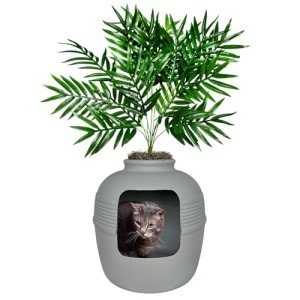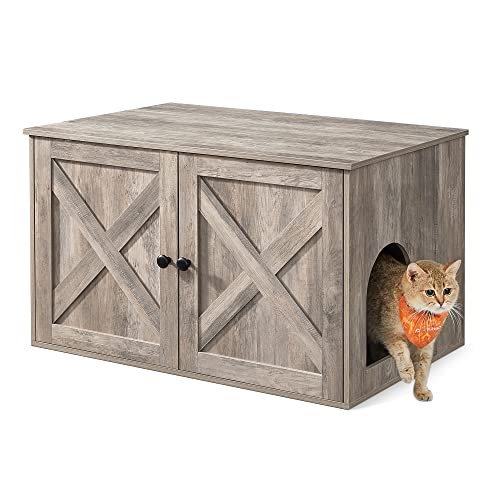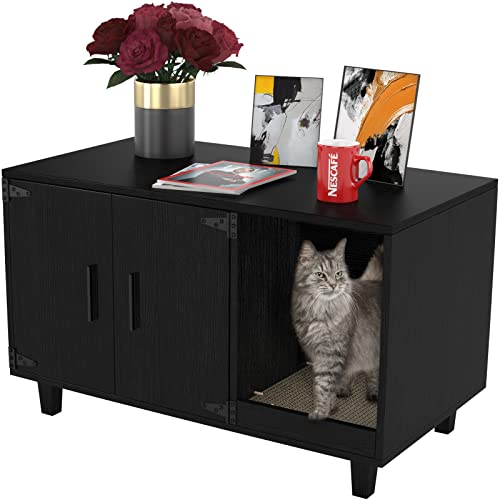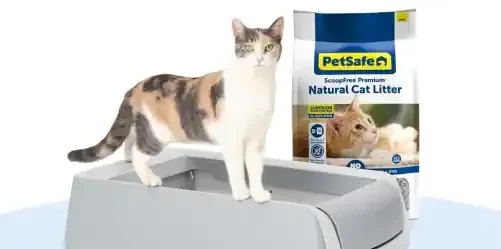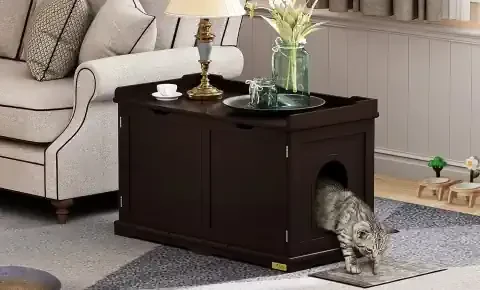Understanding the Importance of a Proper Cat Litter Box Setup
A clean and appropriately designed litter box is not just a convenience for pet owners; it is essential for the health, well-being, and happiness of our feline companions. In this section, we delve into the critical aspects of maintaining a proper litter box environment.
Importance of a Clean Litter Box
Maintaining cleanliness in your cat's litter box goes beyond mere aesthetics—it directly impacts your cat's physical and mental health. Cats are inherently clean animals, and they instinctively seek out clean areas for elimination. A dirty litter box not only repels cats from using it but also increases the risk of urinary tract infections and other health issues. Ammonia buildup from urine can irritate your cat's respiratory system, leading to discomfort and potential respiratory problems. Therefore, regular cleaning and maintenance of the litter box are paramount.
Impact of Litter Box on Cat Behavior
The design and cleanliness of the litter box can significantly influence your cat's behavior. Cats are creatures of habit, and any deviation from their preferred elimination routine can cause stress and anxiety. A poorly maintained or incorrectly placed litter box may lead to litter box aversion, where cats start avoiding it altogether. This can result in inappropriate elimination behaviors, such as urinating outside the box. Understanding your cat's preferences and providing an environment that caters to their natural instincts is crucial for promoting positive litter box habits.
Health Implications of Improper Litter Box Hygiene
Neglecting proper litter box hygiene can have serious consequences for your cat's health. A dirty litter box harbors bacteria, fungi, and parasites that can cause infections and diseases. Bacterial overgrowth in soiled litter can lead to urinary tract infections (UTIs) and other urinary issues. Cats may also develop skin infections or digestive problems from coming into contact with contaminated litter. Moreover, ammonia fumes from accumulated urine can irritate the sensitive mucous membranes of the respiratory tract, exacerbating existing respiratory conditions or causing new ones. By maintaining a clean and hygienic litter box environment, you not only ensure your cat's physical health but also contribute to their overall well-being and quality of life.
This text aims to provide comprehensive insights into the significance of a proper litter box setup, covering the importance of cleanliness, its impact on cat behavior, and the health implications of neglecting hygiene. Let me know if you need further modifications or additional information!
Identifying Common Cat Litter Box Issues
In this section, we will explore the most prevalent problems that cat owners encounter with their litter boxes and understand the underlying causes behind them.
Odor Problems
One of the most common complaints associated with cat litter boxes is odor. Despite regular cleaning, litter boxes can emit unpleasant smells that permeate the surrounding environment. Understanding the factors contributing to odor buildup is essential for effective odor control. Factors such as the type of litter used, frequency of cleaning, and ventilation in the litter box area all play a significant role. Additionally, underlying health issues in cats, such as urinary tract infections or dietary problems, can exacerbate odor problems. By identifying the root cause of odor issues, cat owners can implement targeted strategies to eliminate or minimize unpleasant smells and create a more pleasant living environment for both themselves and their feline companions.
Cat Refusing to Use the Litter Box
Another common issue faced by cat owners is when their feline companions refuse to use the litter box altogether. This behavior, known as litter box aversion, can be frustrating and perplexing for pet owners. Several factors may contribute to a cat's reluctance to use the litter box, including cleanliness, litter type, box size, and location. Cats are creatures of habit, and any change to their litter box environment can trigger aversion behavior. Additionally, underlying medical issues, such as urinary tract infections or arthritis, can cause discomfort and deter cats from using the litter box. Identifying the specific reasons behind a cat's refusal to use the litter box is crucial for implementing effective solutions and restoring proper litter box habits.
Litter Tracking Around the House
Litter tracking, where granules of litter are scattered around the house, is a common issue that many cat owners face. Not only is litter tracking unsightly, but it can also be a nuisance to clean up. Several factors contribute to litter tracking, including the type of litter used, the design of the litter box, and the behavior of the cat. Cats naturally kick up litter when covering their waste, and certain litter types are more prone to tracking than others. Additionally, litter box designs that lack adequate containment or entry points can contribute to tracking issues. By implementing strategies to minimize litter tracking, such as using litter mats or choosing low-tracking litter options, cat owners can reduce the mess and maintain a cleaner living environment.
Inappropriate Urination or Defecation
Inappropriate urination or defecation outside the litter box is a behavior that many cat owners find challenging to address. Cats may engage in this behavior due to various reasons, including medical issues, stress or anxiety, territorial conflicts, or dissatisfaction with the litter box environment. Identifying the underlying cause of inappropriate elimination behavior is essential for implementing effective solutions. Consulting with a veterinarian to rule out any medical issues is the first step in addressing this problem. Once medical issues have been ruled out, cat owners can focus on environmental factors, such as litter box cleanliness, location, and accessibility, to encourage proper litter box usage. Additionally, providing environmental enrichment and reducing stressors in the cat's environment can help alleviate anxiety and prevent future incidents of inappropriate elimination.
Addressing Odor Control in the Litter Box
In this section, we delve into strategies for effectively managing and minimizing odors emanating from the cat litter box, ensuring a more pleasant environment for both cats and their owners.
Choosing the Right Type of Litter for Odor Control
Selecting the appropriate litter is paramount for controlling odors in the litter box. Various types of litter are available on the market, each with its unique odor-controlling properties. Clumping litters, made from materials such as clay or silica gel, are popular choices due to their ability to absorb and encapsulate moisture and odors effectively. Additionally, litter brands may offer specialized formulas infused with odor-neutralizing agents, such as baking soda or activated charcoal, to combat unpleasant smells. When choosing litter for odor control, cat owners should consider their cat's preferences, litter box setup, and budgetary constraints to find the most suitable option.
Using Odor-Neutralizing Additives
In addition to selecting the right litter, cat owners can enhance odor control by incorporating odor-neutralizing additives into the litter box. These additives work by chemically binding with odor molecules, neutralizing them and reducing their potency. Common odor-neutralizing additives include baking soda, activated charcoal, and natural enzymes. Cat owners can sprinkle these additives directly onto the litter or mix them into the litter substrate to enhance odor control. Regularly replenishing odor-neutralizing additives can help maintain a fresh-smelling litter box environment and prolong the effectiveness of odor control measures.
Cleaning and Maintaining the Litter Box Regularly
Regular cleaning and maintenance are essential for preventing odor buildup in the litter box. Cat owners should establish a consistent cleaning routine, scooping out waste and clumps of urine at least once or twice daily. Additionally, it is recommended to perform a thorough cleaning of the litter box on a weekly basis, emptying the entire contents, and washing the box with mild soap and water. Completely replacing the litter on a monthly or bi-monthly basis is also necessary to prevent odor accumulation. Proper ventilation in the litter box area can further aid in dissipating odors and maintaining a fresh-smelling environment. By incorporating these cleaning practices into their routine, cat owners can effectively manage odors and create a more hygienic living space for both themselves and their feline companions.
Encouraging Litter Box Usage
In this section, we explore strategies to encourage cats to use their litter boxes consistently, promoting proper elimination habits and reducing the likelihood of accidents outside the litter box.
Placing the Litter Box in the Right Location
The placement of the litter box plays a crucial role in encouraging cats to use it regularly. Cats prefer privacy and security when using the litter box, so it's essential to choose a quiet, low-traffic area of the home for placement. Additionally, cats may have preferences regarding the type of surface they prefer for elimination, such as carpeting versus hardwood floors. Observing your cat's behavior and preferences can help determine the optimal location for the litter box. Avoid placing the litter box near noisy appliances, feeding areas, or areas with high foot traffic, as these factors may deter cats from using it.
Ensuring the Litter Box is Clean and Accessible
A clean litter box is more inviting to cats and encourages regular use. Cat owners should establish a consistent cleaning routine, scooping out waste and clumps of urine daily to maintain cleanliness. Additionally, the litter box should be large enough to accommodate your cat comfortably, with sufficient depth of litter for digging and covering waste. Cats may avoid using litter boxes that are too small or filled with too much litter, so it's essential to provide an appropriate-sized box and monitor litter levels regularly. Accessibility is also key, particularly for senior cats or those with mobility issues. Choose litter boxes with low entry points or provide ramps for easy access.
Using Positive Reinforcement Techniques
Positive reinforcement can be a powerful tool for encouraging litter box usage in cats. Whenever your cat uses the litter box appropriately, praise and reward them with treats or affection. Positive reinforcement helps to reinforce desirable behaviors and creates a positive association with the litter box. Conversely, avoid punishing or scolding your cat for accidents outside the litter box, as this can create fear and anxiety and may exacerbate the problem. Consistency is key when using positive reinforcement techniques, so be sure to reward your cat consistently for using the litter box correctly.
Addressing Changes or Stressors in the Environment
Changes or stressors in the environment can contribute to litter box aversion and inappropriate elimination behaviors in cats. Cats are sensitive to changes in their surroundings, such as moving to a new home, the addition of a new pet or family member, or changes in routine. These changes can cause stress and anxiety, leading to litter box problems. Minimizing stressors and providing a stable, predictable environment for your cat can help prevent litter box issues. Additionally, providing environmental enrichment, such as interactive toys, scratching posts, and vertical spaces, can help alleviate boredom and reduce stress in cats, promoting better litter box habits.
Minimizing Litter Tracking
In this section, we explore effective strategies for reducing the tracking of litter around the house, maintaining a cleaner living environment for both cats and their owners.
Investing in Litter Mats
Litter mats are an invaluable tool for minimizing litter tracking around the house. These mats are placed outside the litter box to capture stray litter granules as cats exit the box. Litter mats come in various shapes, sizes, and materials, including rubber, silicone, and carpeting. Choose a litter mat with a textured surface that effectively traps litter particles while allowing easy cleanup. Additionally, opt for a mat with a non-slip backing to prevent shifting or sliding on smooth surfaces. Regularly vacuuming or shaking out the litter mat helps to remove trapped litter and maintain its effectiveness in reducing tracking.
Choosing Low-Tracking Litter Options
Certain types of litter are less prone to tracking than others, making them ideal choices for minimizing litter mess around the house. Lightweight litters, such as those made from recycled paper or pine pellets, tend to produce less tracking compared to heavier clay-based litters. Additionally, consider selecting litters with larger granule sizes, as these are less likely to cling to your cat's paws and be tracked outside the litter box. Experimenting with different litter options allows cat owners to find the most suitable choice for their cat's preferences and their home environment.
Regularly Cleaning the Area Around the Litter Box
Regular maintenance of the area around the litter box is essential for minimizing litter tracking and maintaining a tidy living space. Sweep or vacuum the floors surrounding the litter box daily to remove stray litter granules. Pay particular attention to corners, crevices, and baseboards where litter may accumulate. Additionally, consider placing a secondary litter mat or rug in front of the litter box to capture any litter particles that may be tracked further from the box. By incorporating these cleaning practices into your routine, you can effectively reduce litter tracking and keep your home cleaner and more comfortable for both you and your cat.
Dealing with Cat Refusing to Use the Litter Box
In this section, we explore strategies for addressing litter box aversion and encouraging cats to use their litter boxes consistently, promoting proper elimination habits and reducing accidents outside the box.
Rule Out Medical Issues
When a cat refuses to use the litter box, it's essential to rule out any underlying medical issues that may be contributing to the problem. Urinary tract infections, bladder stones, and other health conditions can cause discomfort or pain during urination, leading cats to avoid the litter box. Schedule a veterinary examination to rule out any medical issues and address them promptly if detected. Once medical concerns have been addressed, you can focus on addressing behavioral or environmental factors contributing to litter box aversion.
Addressing Stress or Anxiety
Stress or anxiety can contribute to litter box aversion in cats. Changes in the environment, such as moving to a new home, the addition of a new pet or family member, or changes in routine, can trigger stress in cats and lead to litter box problems. Provide a calm, stable environment for your cat and minimize stressors as much as possible. Create designated safe spaces where your cat can retreat and relax, away from noise and commotion. Additionally, consider implementing environmental enrichment strategies, such as interactive toys, puzzle feeders, and vertical spaces, to provide mental stimulation and reduce stress.
Experimenting with Different Litter Types or Box Styles
Cats may have preferences regarding the type of litter and litter box style they prefer. Experimenting with different litter options, such as clumping clay, silica gel, recycled paper, or natural wood pellets, allows you to identify the most suitable choice for your cat's preferences. Similarly, try offering litter boxes with varying dimensions, entry points, and styles to determine which design your cat prefers. Some cats may prefer covered litter boxes for added privacy, while others may prefer open-top boxes for easy access and ventilation. By offering choices and observing your cat's behavior, you can identify the optimal litter and litter box setup that encourages consistent litter box usage.
Managing Multiple Cat Household Litter Box Challenges
In this section, we explore strategies for managing litter box challenges in households with multiple cats, ensuring each cat has access to a clean and appropriate elimination area.
Providing Multiple Litter Boxes
In multi-cat households, it's essential to provide multiple litter boxes to accommodate the needs of each cat. The general rule of thumb is to have one litter box per cat plus an additional box to prevent competition and overcrowding. Place litter boxes in separate locations throughout the home to provide cats with options and prevent territorial disputes. Additionally, ensure that litter boxes are distributed evenly to avoid congestion in specific areas. Providing multiple litter boxes allows each cat to have its designated elimination space, reducing stress and promoting proper litter box usage.
Ensuring Each Cat Has Its Own Space
Cats are territorial animals and may feel threatened or intimidated when sharing litter boxes with other cats. Ensure that each cat has its own designated space for eating, sleeping, and eliminating to minimize conflict and promote harmony in the household. Place litter boxes in quiet, low-traffic areas where cats can use them without feeling threatened by other pets or household members. Additionally, provide vertical spaces, such as cat trees or shelves, where cats can retreat and observe their surroundings without feeling vulnerable. By creating separate spaces for each cat, you can reduce competition and promote peaceful coexistence among multiple pets.
Monitoring and Resolving Territorial Issues
Territorial conflicts can arise in multi-cat households, leading to litter box problems and inappropriate elimination behaviors. Monitor your cats' behavior closely for signs of aggression, tension, or territorial marking. Address any conflicts or disputes promptly to prevent escalation and maintain a harmonious living environment. Provide environmental enrichment, such as interactive toys, scratching posts, and hiding spots, to keep cats mentally stimulated and alleviate boredom. Additionally, consider implementing scent-swapping techniques, where you exchange bedding or toys between cats to promote familiarity and reduce tension. By addressing territorial issues and providing a conducive environment for all cats, you can minimize litter box challenges and promote proper elimination habits.
Overcoming Inappropriate Elimination Behaviors
In this section, we explore strategies for addressing inappropriate elimination behaviors in cats, helping to restore proper litter box habits and maintain a clean living environment.
Understanding the Reasons Behind the Behavior
Inappropriate elimination behaviors can stem from various underlying reasons, including medical issues, stress or anxiety, territorial conflicts, or dissatisfaction with the litter box environment. It's essential to identify the specific triggers contributing to the behavior to implement targeted solutions effectively. Observing your cat's behavior, monitoring changes in the environment, and consulting with a veterinarian can help pinpoint the root cause of inappropriate elimination.
Cleaning and Neutralizing Affected Areas
Promptly cleaning and neutralizing areas where your cat has eliminated outside the litter box is crucial for preventing repeat incidents and discouraging the behavior. Use enzymatic cleaners specifically designed to break down organic stains and odors effectively. Avoid using ammonia-based cleaners, as they can exacerbate the problem by mimicking the scent of urine, attracting your cat to the same spot for elimination. Thoroughly clean and disinfect the affected area to remove any lingering odors and prevent your cat from returning to the same spot.
Consulting with a Veterinarian or Animal Behaviorist if Necessary
If inappropriate elimination behaviors persist despite your efforts, it's essential to consult with a veterinarian or animal behaviorist for further evaluation and guidance. A veterinarian can rule out any underlying medical issues contributing to the behavior and recommend appropriate treatment options if necessary. An animal behaviorist can help assess your cat's behavior, identify triggers, and develop a behavior modification plan tailored to your cat's specific needs. Working with professionals experienced in feline behavior can provide valuable insights and support in addressing inappropriate elimination behaviors and restoring proper litter box habits.
Creating a Long-Term Plan for Litter Box Success
In this final section, we discuss the importance of establishing a long-term plan for maintaining proper litter box habits in cats, ensuring a clean and hygienic environment for both cats and their owners.
Establishing a Consistent Cleaning Routine
Consistency is key to maintaining proper litter box habits in cats. Establish a regular cleaning routine that includes daily scooping of waste and clumps, as well as weekly deep cleaning of the litter box. Set aside dedicated time each day to attend to the litter box, ensuring that it remains clean and inviting for your cat. Consistent maintenance helps prevent odor buildup, reduces the risk of litter box aversion, and promotes regular use by your cat.
Monitoring Cat Behavior and Making Necessary Adjustments
Stay vigilant and monitor your cat's behavior closely for any signs of litter box problems or changes in elimination habits. Pay attention to subtle cues, such as avoiding the litter box, excessive scratching or grooming around the genital area, or vocalizing while urinating or defecating. Address any issues promptly by identifying and addressing underlying causes, such as stress, medical problems, or environmental factors. Make necessary adjustments to the litter box setup, such as changing litter type or box style, to accommodate your cat's preferences and promote consistent litter box usage.
Being Proactive in Addressing Any Issues That Arise
Proactivity is essential in maintaining proper litter box habits and preventing problems from escalating. Stay proactive by addressing any issues or concerns that arise promptly and effectively. Whether it's resolving litter box aversion, managing territorial conflicts, or addressing medical issues, take proactive steps to identify and address the root cause of the problem. Consult with professionals, such as veterinarians or animal behaviorists, for guidance and support in implementing appropriate solutions. By being proactive and addressing issues as they arise, you can ensure a clean, hygienic, and stress-free litter box environment for your cat and promote long-term litter box success.

